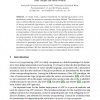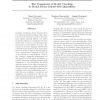1000 search results - page 141 / 200 » An RDF Query Language based on Logic Programming |
ICLP
2005
Springer
15 years 3 months ago
2005
Springer
Abstract. In recent work, a general framework for specifying program correspondences under the answer-set semantics has been defined. The framework allows to define different not...
132
click to vote
VL
2010
IEEE
14 years 8 months ago
2010
IEEE
Many machine-learning algorithms learn rules of behavior from individual end users, such as taskoriented desktop organizers and handwriting recognizers. These rules form a “prog...
ICLP
1997
Springer
15 years 1 months ago
1997
Springer
Kowalski and Sergot’s Event Calculus (EC) is a simple temporal formalism that, given a set of event occurrences, derives the maximal validity intervals (MVIs) over which propert...
SIGMOD
2001
ACM
15 years 10 months ago
2001
ACM
We study the problem of generating e cient, equivalent rewritings using views to compute the answer to a query. We take the closed-world assumption, in which views are materialize...
UAI
2008
14 years 11 months ago
2008
Formal languages for probabilistic modeling enable re-use, modularity, and descriptive clarity, and can foster generic inference techniques. We introduce Church, a universal langu...


